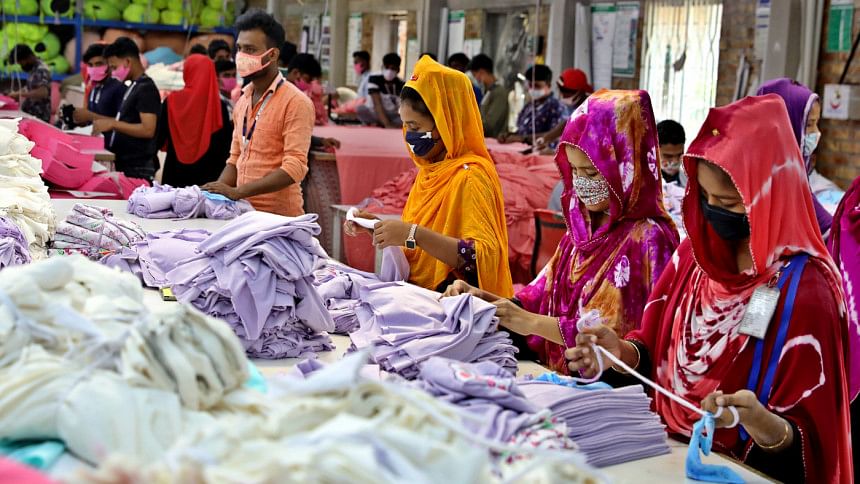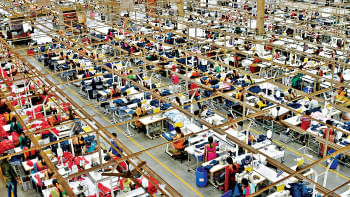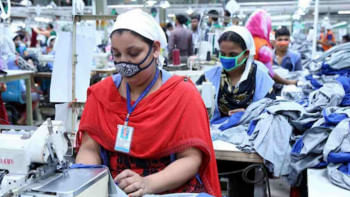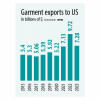Garment exports to US show signs of recovery

Garment export to the United States, Bangladesh's single largest market, is showing signs of a rebound on the back of a revival of the world's largest economy, consumers opening up their wallets, and falling inflation.
In 2023, apparel shipment to the US from the country fell 25 percent. The decline narrowed to 19.24 percent in the first two months of 2024, data from the Office of Textiles and Apparel (OTEXA), a body under the American Commerce Department, showed.
"Apparel export to the US will continue to grow in the coming months and the volume may cross the $10-billion mark at the end of 2024," said Faruque Hassan, the immediate past president of the Bangladesh Garment Manufacturers and Exporters Association (BGMEA).
US clothing retailers and brands imported fewer apparel items from all over the world in the last two years due to unsold inventories as stocks piled up amid lower consumption during the peak of the coronavirus pandemic.
The trend persisted last year because the severe fallout of Covid-19 and the Russia-Ukraine war sent inflation to a multi-decade high, eroding the purchasing power of consumers.
The sales started to pick up in November last year and inventories ran out, leading to a rise in orders for goods from Bangladesh and other countries.
"Garment export to the US fell almost every month last year and it went up from the beginning this year," said BGMEA's Hassan.
Garment export to the US stood at $1.18 billion in January and February. The collective shipments of textiles and garments were $1.21 billion, a slip of 18.88 percent.
Among all garment-exporting nations, Bangladesh holds the third position in the US, trailing China and Vietnam. However, the country is the top denim exporter to the US.
Bangladesh has emerged as an attractive sourcing destination for US retailers and brands thanks to competitive pricing and a higher capability for executing orders, which has boosted their confidence, according to exporters.
The National Retail Federation (NRF), the largest trade body for retailers in the US, stated in a forecast on March 20 that retail sales will increase between 2.5 percent and 3.5 percent in 2024, reaching between $5.23 trillion and $5.28 trillion. This is due to the continued resilience of consumers powering the American economy.
In a press release, NRF President and CEO Matthew Shay said, "The resilience of consumers continues to power the American economy, and we are confident there will be moderate but steady growth through the end of the year."
"Successful retailers offer consumers products and services when, where, and how they want to shop, at prices they are willing to pay."
The 2024 sales forecast compares with a 3.6 percent annual sales growth of $5.1 trillion in 2023. The 2024 forecast aligns with the 10-year pre-pandemic average annual sales growth of 3.6 percent.
Non-store and online sales, which are included in the total figure, are expected to grow between 7 percent and 9 percent year-over-year, reaching a range of $1.47 trillion to $1.50 trillion. This compares with non-store and online sales of $1.38 trillion in 2023.
NRF projects full-year GDP growth of around 2.3 percent, a slower pace than the 2.5 percent in 2023, but strong enough to sustain job growth.
Inflation is also expected to moderate to 2.2 percent on a year-over-year basis, due to a cooling economy, the labour and product market coming into better balance, and retreating housing costs.
"The economy is primarily supported by consumers who have shown much greater resilience than expected, and it's hard to be bearish on the consumer," said NRF Chief Economist Jack Kleinhenz in the press release.
"The question for 2024 ultimately is, will consumer spending maintain its resilience?"
Kleinhenz also noted rising home and stock prices in 2023 likely stimulated greater consumer spending via the so-called wealth effect, and this should continue in 2024.
"Several surveys reveal that consumers appear to have a favourable outlook, which should also support their willingness to spend. However, many consumers are feeling a pinch from tighter credit and inflation."

 For all latest news, follow The Daily Star's Google News channel.
For all latest news, follow The Daily Star's Google News channel. 










Comments